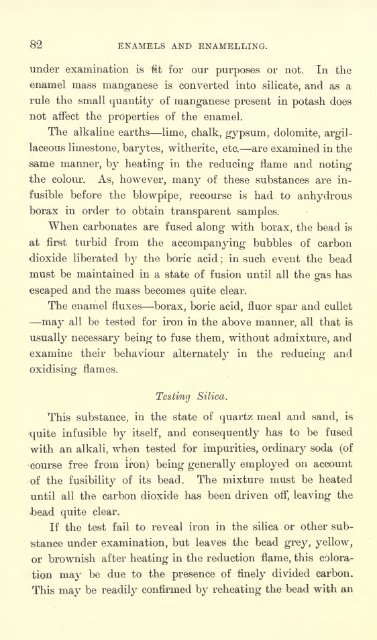Enamels and enamelling; an introduction to the preparation and ...
Enamels and enamelling; an introduction to the preparation and ...
Enamels and enamelling; an introduction to the preparation and ...
You also want an ePaper? Increase the reach of your titles
YUMPU automatically turns print PDFs into web optimized ePapers that Google loves.
82 ENAMELS AND ENAMELLING.<br />
under examination is fit for our purposes or not. In <strong>the</strong><br />
enamel mass m<strong>an</strong>g<strong>an</strong>ese is converted in<strong>to</strong> silicate, <strong><strong>an</strong>d</strong> as a<br />
rule <strong>the</strong> small qu<strong>an</strong>tity of m<strong>an</strong>g<strong>an</strong>ese present in potash does<br />
not affect <strong>the</strong> properties of <strong>the</strong> enamel.<br />
The alkaline earths lime, chalk, gypsum, dolomite, argil-<br />
laceous limes<strong>to</strong>ne, barytes, wi<strong>the</strong>rite,<br />
etc. are examined in <strong>the</strong><br />
same m<strong>an</strong>ner, by heating in <strong>the</strong> reducing flame <strong><strong>an</strong>d</strong> noting<br />
<strong>the</strong> colour. As, however, m<strong>an</strong>y<br />
of <strong>the</strong>se subst<strong>an</strong>ces are in-<br />
fusible before <strong>the</strong> blowpipe, recourse is had <strong>to</strong> <strong>an</strong>hydrous<br />
borax in order <strong>to</strong> obtain tr<strong>an</strong>sparent samples.<br />
When carbonates are fused along with borax, <strong>the</strong> bead is<br />
at first turbid from <strong>the</strong> accomp<strong>an</strong>ying bubbles of carbon<br />
dioxide liberated by <strong>the</strong> boric acid ; in such event <strong>the</strong> bead<br />
must be maintained in a state of fusion until all <strong>the</strong> gas has<br />
O<br />
escaped <strong><strong>an</strong>d</strong> <strong>the</strong> mass becomes quite clear.<br />
The enamel fluxes borax, boric acid, fluor spar <strong><strong>an</strong>d</strong> cullet<br />
may all be tested for iron in <strong>the</strong> above m<strong>an</strong>ner, all that is<br />
usually necessary being <strong>to</strong> fuse <strong>the</strong>m, without admixture, <strong><strong>an</strong>d</strong><br />
examine <strong>the</strong>ir behaviour alternately in <strong>the</strong> reducing <strong><strong>an</strong>d</strong><br />
oxidising flames.<br />
Testing Silica.<br />
This subst<strong>an</strong>ce, in <strong>the</strong> state of quartz meal <strong><strong>an</strong>d</strong> s<strong><strong>an</strong>d</strong>, is<br />
quite infusible by itself, <strong><strong>an</strong>d</strong> consequently has <strong>to</strong> be fused<br />
with <strong>an</strong> alkali, when tested for impurities, ordinary soda (of<br />
course free from iron) being generally employed on account<br />
of <strong>the</strong> fusibility of its bead. The mixture must be heated<br />
until all <strong>the</strong> carbon dioxide has been driven off, leaving <strong>the</strong><br />
bead quite clear.<br />
If <strong>the</strong> test fail <strong>to</strong> reveal iron in <strong>the</strong> silica or o<strong>the</strong>r sub-<br />
st<strong>an</strong>ce under examination, but leaves <strong>the</strong> bead grey, yellow,<br />
or brownish after heating in <strong>the</strong> reduction flame, this colora-<br />
tion may be due <strong>to</strong> <strong>the</strong> presence of finely divided carbon.<br />
This mav be readily confirmed by reheating <strong>the</strong> bead with <strong>an</strong>
















